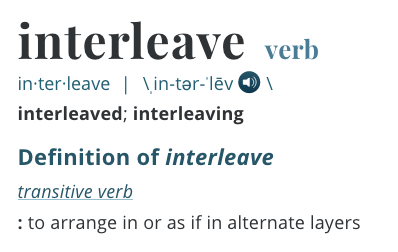But then I learned this word, interleave, in a book I'm listening to (audiobooks are the best!) by Peter C. Brown, Make It Stick: The Science of Successful Learning (2014). He explains that topics are learned better when they are interleaved--or arranged in layers. I imagine a deck of cards being shuffled. Split the deck with development subtopics on one side and diseases subtopics on the other--now shuffle them up and the topics are interleaved.
This still doesn't seem intuitive to me. Isn't this going to take longer? Are students going to be more confused jumping around topics that are unrelated? Yes, in fact, it will take longer to teach and learn. But that's the point. Research has shown the brain is working harder to recall learning that is interleaved. When the brain works hard to remember in the present, it remembers easier in the future. Also, interleaving allows for connections to develop between seemingly unconnected topics. Interleaving could address two barriers in nursing education and practice--silos and clinical judgment. Much of nursing (and healthcare) education and practice is siloed. Separate courses for pediatrics, women's health, community, etc. Separate departments for nursing, medicine, respiratory therapy, etc. Nothing about silos is reality--life is interleaved. So why are we teaching students topics in silos? I can't change the courses that are offered, but I can at least interleave the topics I teach in my course. I'm pretty sure nursing instructors think clinical judgment is the panacea for all barriers to quality nursing practice. Clinical judgment requires one to take in all information available, prioritize what is important, set aside what is not important (don't forget it though, it might be important later!), determine a goal...you get the idea of the nursing process. If we present information in silos, how can we expect students to analyze interleaved data? How do we help them put it all together and provide holistic care? Rather than teach all the topics and then have students "put it together" at the end of the course, interleaving throughout the course can help students make connections and develop their data analysis skills. All this thinking about layers has made me hungry. I'm off to find layer cake... 7 layer salad... lasagna... nachos... shortcake triffle...
0 Comments
Leave a Reply. |
About
An occasional blog about teaching, learning, and life ArchivesCategories
|
Proudly powered by Weebly

 RSS Feed
RSS Feed